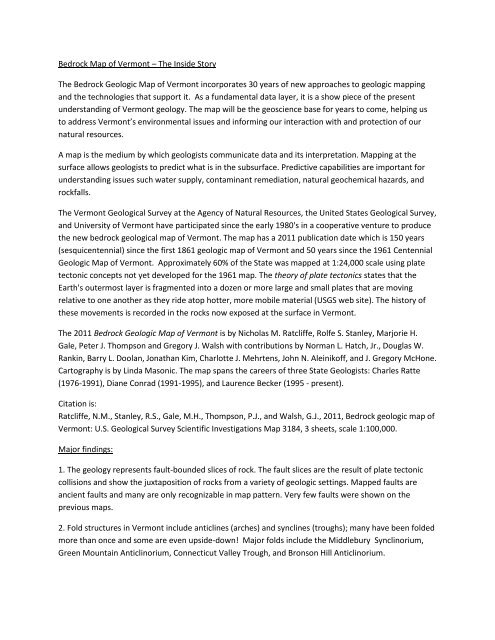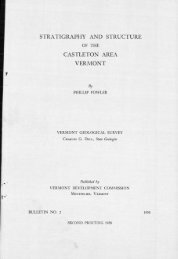The Inside Story - Vermont Agency of Natural Resources
The Inside Story - Vermont Agency of Natural Resources
The Inside Story - Vermont Agency of Natural Resources
You also want an ePaper? Increase the reach of your titles
YUMPU automatically turns print PDFs into web optimized ePapers that Google loves.
Bedrock Map <strong>of</strong> <strong>Vermont</strong> – <strong>The</strong> <strong>Inside</strong> <strong>Story</strong><br />
<strong>The</strong> Bedrock Geologic Map <strong>of</strong> <strong>Vermont</strong> incorporates 30 years <strong>of</strong> new approaches to geologic mapping<br />
and the technologies that support it. As a fundamental data layer, it is a show piece <strong>of</strong> the present<br />
understanding <strong>of</strong> <strong>Vermont</strong> geology. <strong>The</strong> map will be the geoscience base for years to come, helping us<br />
to address <strong>Vermont</strong>’s environmental issues and informing our interaction with and protection <strong>of</strong> our<br />
natural resources.<br />
A map is the medium by which geologists communicate data and its interpretation. Mapping at the<br />
surface allows geologists to predict what is in the subsurface. Predictive capabilities are important for<br />
understanding issues such water supply, contaminant remediation, natural geochemical hazards, and<br />
rockfalls.<br />
<strong>The</strong> <strong>Vermont</strong> Geological Survey at the <strong>Agency</strong> <strong>of</strong> <strong>Natural</strong> <strong>Resources</strong>, the United States Geological Survey,<br />
and University <strong>of</strong> <strong>Vermont</strong> have participated since the early 1980's in a cooperative venture to produce<br />
the new bedrock geological map <strong>of</strong> <strong>Vermont</strong>. <strong>The</strong> map has a 2011 publication date which is 150 years<br />
(sesquicentennial) since the first 1861 geologic map <strong>of</strong> <strong>Vermont</strong> and 50 years since the 1961 Centennial<br />
Geologic Map <strong>of</strong> <strong>Vermont</strong>. Approximately 60% <strong>of</strong> the State was mapped at 1:24,000 scale using plate<br />
tectonic concepts not yet developed for the 1961 map. <strong>The</strong> theory <strong>of</strong> plate tectonics states that the<br />
Earth's outermost layer is fragmented into a dozen or more large and small plates that are moving<br />
relative to one another as they ride atop hotter, more mobile material (USGS web site). <strong>The</strong> history <strong>of</strong><br />
these movements is recorded in the rocks now exposed at the surface in <strong>Vermont</strong>.<br />
<strong>The</strong> 2011 Bedrock Geologic Map <strong>of</strong> <strong>Vermont</strong> is by Nicholas M. Ratcliffe, Rolfe S. Stanley, Marjorie H.<br />
Gale, Peter J. Thompson and Gregory J. Walsh with contributions by Norman L. Hatch, Jr., Douglas W.<br />
Rankin, Barry L. Doolan, Jonathan Kim, Charlotte J. Mehrtens, John N. Aleinik<strong>of</strong>f, and J. Gregory McHone.<br />
Cartography is by Linda Masonic. <strong>The</strong> map spans the careers <strong>of</strong> three State Geologists: Charles Ratte<br />
(1976-1991), Diane Conrad (1991-1995), and Laurence Becker (1995 - present).<br />
Citation is:<br />
Ratcliffe, N.M., Stanley, R.S., Gale, M.H., Thompson, P.J., and Walsh, G.J., 2011, Bedrock geologic map <strong>of</strong><br />
<strong>Vermont</strong>: U.S. Geological Survey Scientific Investigations Map 3184, 3 sheets, scale 1:100,000.<br />
Major findings:<br />
1. <strong>The</strong> geology represents fault-bounded slices <strong>of</strong> rock. <strong>The</strong> fault slices are the result <strong>of</strong> plate tectonic<br />
collisions and show the juxtaposition <strong>of</strong> rocks from a variety <strong>of</strong> geologic settings. Mapped faults are<br />
ancient faults and many are only recognizable in map pattern. Very few faults were shown on the<br />
previous maps.<br />
2. Fold structures in <strong>Vermont</strong> include anticlines (arches) and synclines (troughs); many have been folded<br />
more than once and some are even upside-down! Major folds include the Middlebury Synclinorium,<br />
Green Mountain Anticlinorium, Connecticut Valley Trough, and Bronson Hill Anticlinorium.
3. <strong>The</strong>re are 51 new age dates on the map. <strong>The</strong> ages <strong>of</strong> the bedrock in <strong>Vermont</strong> range from<br />
Mesoproterozoic (1.4 billion years) to Miocene (20 million years). <strong>The</strong> oldest dated rocks in <strong>Vermont</strong> are<br />
from South Londonderry, VT; the youngest unit on the map is the Brandon lignite, a small deposit <strong>of</strong><br />
brown coal and clay, which is dated as 20 million years old based on fossil seeds and flora.<br />
4. Rock geochemistry has provided data to discern different ancient plate tectonic environments such as<br />
rifted or broken apart continental crust, mid-ocean ridge spreading centers, and volcanic island arcs.<br />
5. Rocks <strong>of</strong> the ancient continental margin, fragments <strong>of</strong> oceanic crust, and relict metamorphic rocks<br />
from subduction zones are part <strong>of</strong> the <strong>Vermont</strong> landscape and provide some important deposits such as<br />
marble, talc and slate.<br />
6. Age, geochemistry, structure, and plate tectonic environment impact the interpretations shown in the<br />
cross-sections. Cross-sections are projected to a depth <strong>of</strong> 10 km.<br />
Comparison <strong>of</strong> 1861, 1961 and 2011 maps:<br />
<strong>The</strong> 1861 Geologic Map <strong>of</strong> <strong>Vermont</strong> was begun in 1845 by State Geologist Charles Adams, work<br />
continued by Zadock Thompson and Augustus Young, and the map was completed by Edward Hitchcock.<br />
<strong>The</strong> map focused on ores, had 24 map units, had no topographic base, and was at a scale <strong>of</strong> 1:400,000.<br />
<strong>The</strong> Centennial Geologic Map <strong>of</strong> <strong>Vermont</strong> by Charles Doll, Wallace Cady, James Thompson and Marland<br />
Billings was published 100 years later in 1961 at a scale <strong>of</strong> 1:250,000. It was the first map to show<br />
stratigraphy for the state and assign ages to the formations. It had 137 map units, 2745 polygons.<br />
<strong>The</strong> 2011 Bedrock Geologic Map <strong>of</strong> <strong>Vermont</strong> (scale 1:100,000) is more detailed than previous work,<br />
contains 486 different rock types and 22,000 polygons. It is the first map published since the<br />
development <strong>of</strong> plate tectonics. <strong>The</strong> map is available as paper copy, digital images and in GIS format,<br />
allowing users to select and highlight units and use the map as a computer-generated data set for<br />
evaluating a multitude <strong>of</strong> issues.<br />
Map-making process:<br />
<strong>The</strong> new map incorporates field mapping studies at various scales by more than 60 geologists. Mapping<br />
was done by pace and compass on a variety <strong>of</strong> base maps and there was no use <strong>of</strong> GPS or digital GIS<br />
mapping in 1984. Geologists observe the exposed rock types and structures (folds, faults, fractures) in<br />
the field, sample the rock for microscopic, chemical, and geochronological studies, then use this<br />
information to develop a three dimensional model <strong>of</strong> the underlying bedrock and to understand the<br />
depositional and deformational history <strong>of</strong> <strong>Vermont</strong>. Maps were hand drafted in ink on mylar,<br />
reproduced on paper, then hand colored. <strong>The</strong> entire process from field work to map publication is labor<br />
intensive. Mapping is still done through walking the land, but now (2011) incorporates the use <strong>of</strong> Global<br />
Positioning Systems (GPS) and Geographic Information Systems (GIS). For more on making the map and<br />
a timeline, please see http://www.anr.state.vt.us/dec/geo/BedrockMap<strong>of</strong>VTHistory.htm<br />
Map Elements:<br />
<strong>The</strong> bedrock geological map shows: the type <strong>of</strong> intact, continuous, solid bedrock at or near the earth's
surface projected onto a 2 -dimensional surface; rock descriptions; age relationships shown on a<br />
correlation <strong>of</strong> units chart; major structures and tectonic elements on a generalized map; cross-sections<br />
which show the interpretation <strong>of</strong> the map pattern in the subsurface and projected in the air; quadrangle<br />
index maps; and references.<br />
Geologic tidbits:<br />
Of national significance, zircon obtained from the Braintree Complex in <strong>Vermont</strong> proved to yield<br />
exceptionally reproducible results and has become the mineral standard (R33) used by Stanford<br />
University, USGS, and other national laboratories. <strong>The</strong> mineral zircon is used to obtain uranium-lead age<br />
dates for igneous rocks.<br />
Fossil control is good in the Champlain Valley and Taconics, but fossils are rare elsewhere. However,<br />
conodonts (microscopic fossil teeth <strong>of</strong> an eel-like animal) were reported by Ratcliffe et al., 1999, in rocks<br />
from West Bridgewater in the heart <strong>of</strong> the Green Mountains. Conodonts were later found at Buels Gore<br />
and are a species, Leptochirognathus quadratus, which lived only from about 463 to 460 Ma (Thompson<br />
et al., 2002b). <strong>The</strong>refore, the rocks are much younger than previously thought and the conodonts<br />
provide age control for some <strong>of</strong> the faults in <strong>Vermont</strong>.<br />
Doll Peak, just south <strong>of</strong> North Jay Peak, is included on the topographic base map <strong>of</strong> the 2011 map. Doll<br />
Peak was named in honor <strong>of</strong> Charles Doll, editor <strong>of</strong> the 1961 Centennial Geologic Map <strong>of</strong> <strong>Vermont</strong> and<br />
State Geologist from 1947 to 1976.<br />
<strong>The</strong> Champlain Thrust is an ancient world-class thrust fault exposed in Burlington at Lone Rock Point.<br />
<strong>The</strong> fault is mapped in western <strong>Vermont</strong> and continues north into Quebec and south into New York. <strong>The</strong><br />
fault is thought to have moved westward some 35-50 miles. That would put its root zone somewhere to<br />
the east <strong>of</strong> Montpelier and last motion around 350 million years ago.<br />
How to obtain copies <strong>of</strong> the map:<br />
<strong>The</strong> map is sold by the <strong>Vermont</strong> Geological Survey and the US Geological Survey. <strong>The</strong> map is also<br />
available for download from the State and Federal governments as pdf files, shapefiles, and kmz files.<br />
<strong>Vermont</strong> Geological Survey<br />
103 South Main St., Logue Cottage<br />
Waterbury, VT 05671-2420<br />
Phone: 802-654-8951<br />
E-mail: Marjorie.gale@state.vt.us<br />
Web site: http://www.anr.state.vt.us/dec/geo/vgs.htm<br />
Or visit our <strong>of</strong>fice in the VSAC Building, 10 East Allen St.,<br />
Winooski, VT. Please call ahead.<br />
U.S. Geological Survey<br />
Denver, CO 80225, USA<br />
Phone: 888-275-8747<br />
http://www.usgs.gov/pubprod/<br />
http://pubs.usgs.gov/sim/3184/













